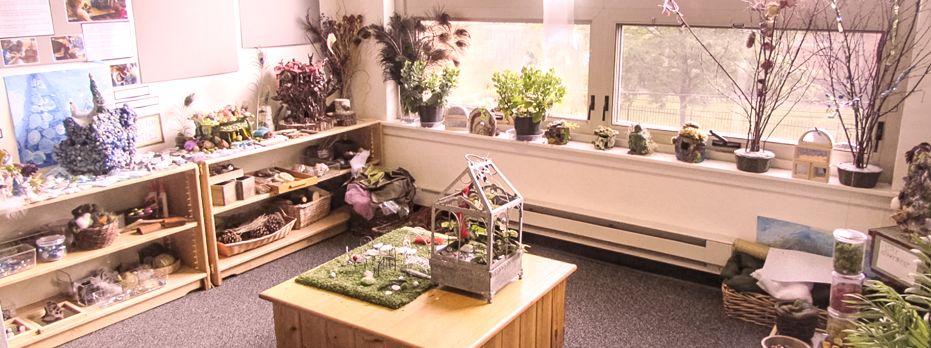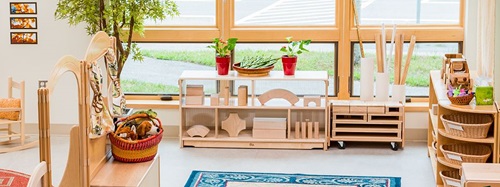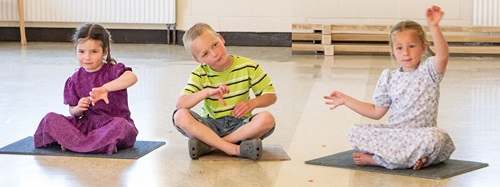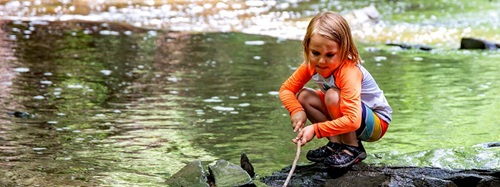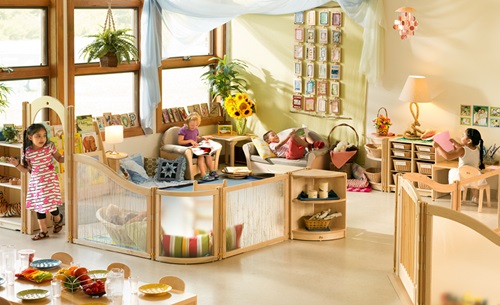Our Montessori Journey with Reggio - Living With Paradox and Dualties
| March 2009MacDonald Montessori Child Care is beginning its 24th year. We are a non-profit center of 185 children, infants through school age, and forty staff , located close to downtown St Paul, Minnesota. We spent our first eight years combining the Montessori philosophy with a half day program of music, art, drama and movement. A core group of Montessori teachers felt strongly that the development of creativity was something not necessarily encouraged in the Montessori classroom of learning materials and we offered exploration of the arts in the other half of the children’s day.
We began hearing about the schools in Reggio Emilia, Italy in 1989 and were immediately intrigued with the beautiful environments and sense of passionate commitment of their educators. We began our search to learn more. It would be another five years before we attended our first workshop and encountered our Italian colleagues, Amelia Gambetti, Carla Rinaldi and Vea Vecchi in Washington D.C. at a conference at the Model Early Learning Center.
We have been through many stages of this journey of inspiration in the Reggio Emilia philosophy—resistance, infatuation, paralysis, fear, excitement, commitment, paralysis, frustration, struggle, exhaustion, recommitment, ecstasy, doubt and once again paralysis.
The Montessori and Reggio philosophies each have their own energies. The following are words that we have chosen to describe our experiences with both approaches:
The Montessori energy is individual, sequential, ordered, independent, linear, historical, masculine, pre-determined, methodical, rigid, an internal process, controlled movement, structured, expected, predictable.
The Reggio Emilia energy is group-centered, cooperative, collaborative, social, open-ended, spiral, expressive process, new age, feminine, flexible, spontaneous, serendipity, open movement, fluid, freely expressive.
Montessori has a pre-determined curriculum and materials set by the teacher with the information flowing from the teacher to the children, more receptive approach from the child’s point of view. Hypotheses are adult established. The emphasis is of a vertical nature.
Reggio’s learning is determined by the children and teachers in collaboration—in a co-learning context—with the ideas flowing between children and teachers and an expressive approach. Problem solving and hypotheses are developed within the triangle of child - teacher - parent interaction. The emphasis is horizontal.
Montessori classroom walls are traditionally bare and visually quiet to focus the children’s attention on the learning materials on the shelves, although ours never were.
Reggio Emilia’s classrooms walls are filled with documentation of the children’s explorations and experiences - photos, conversations, and visual expressions. The walls of the environment are used a tool of reflection and re-visiting by the children, parents and teachers.
The visual arts of clay, paint, collage, drawing, wire and the verbal arts of music, dance, movement, drama are not a priority in the Montessori classroom. However, these arts are seen as Languages of the Child—a hundred, thousand languages each giving children a vehicle for expression and development and a key component of the Reggio school.
They share several points of intersection and connection - both follow the child and enjoy a prepared environment; in fact see the environment the third teacher. Both approaches foster and encourage aestically beautiful schools indoors and out.
In both approaches parents are important; however the Reggio schools view the parents as an essential partner in the schools. In my estimation, Montessori and Reggio both see the child as competent, resourceful and independent; with an key component added—the child is viewed as rich and powerful, with rights rather than needs in the Reggio philosophy.
Well, I bet you are thinking, why did we continue? Many of the obstacles seemed insurmountable and certainly incompatible. There were many stages in our development which explain our desire to move ahead with our feet in two different worlds.
Brightly colored curtains covered our large, expansive windows. It was our desire to make a previous parochial school look homey. We were very attached to the curtains.
We knew the Reggio schools were filled with light and the outdoors were let in. Their windows were used for reflection and a sense of transparency and a place for the visual expressions of children. The removal of the curtains symbolized the earthquake changes happening around us and within us. We were very attached to the curtains, the brightly decorated bulletin boards, the teacher made materials and mobiles, the all weekend decoration of our large resource/large muscle room four times a year. We had a wonderful, creative time as teachers “preparing” the environment FOR the children. All this was changing, reluctantly I might add.
A list of changes we put into place included :
- family panels, classroom pictures, cubby pictures and symbols for each child, and communication centers
- neutralizing( crème, white, gray) all the walls and bulletin boards
- moving the staff room (used only at noon) and changing it into a studio or Atelier
- removal of all teacher-made materials, commercially-made materials
- use of only real photos in books and display (no cartoons)
- development of the entry way as an school identity space and parent information area
- focus on documentation; making the environment personally reflective of the children, parents and teachers and their relationships to each other through sharing children’s projects and learning: children’s conversations, photos, visual expressions
- evaluated our schedules and sense of time, slowing everything down and being more purposeful
- began weekly collaboration meetings amongst the staff in each classroom rather than once a month all staff meetings
In any stage of a relationship, people make choices to terminate or to continue in this journey. Sometimes people also make choices “to take a vacation from each other”. I think that happened to us many times. When staffing issues, parent issues, licensing issues, financial or energy issues overwhelmed us we moved into a state of paralysis to cope and put our emphasis on being able to open our doors everyday. Anyone who is involved in an early childhood program knows many days “opening your doors is a miracle.”
The Reggio Emilia philosophy challenges us to rethink, refigure, reflect on our view of the child, our view of the daily life of children (curriculum), the role of the teacher, the role of the parents, the role of the environment, and there is no end to the challenge.
Paradoxes and Dualities are a part of everyone’s life and they have been with us every step of the way. Hope and disappointment, structure and freedom, joy and sorrow, night and day, order and spontaneity. We keep one foot in each philosophy and the dance is created as we move back and forth between the two. We hold the tension between the two and know that growth and wisdom and the journey happens in the dance.

